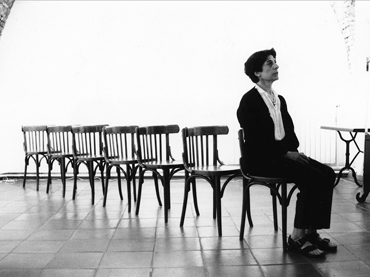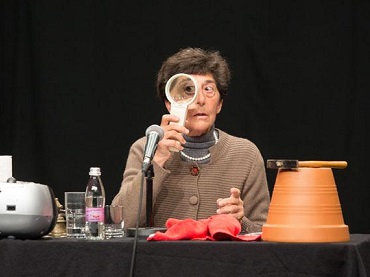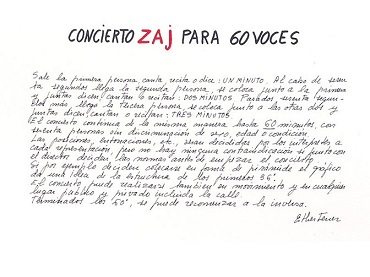-
Friday, 27 October 2017 Edificio Nouvel, Auditorio 200
Encounter with Esther Ferrer
In conversation with Laurence Rassel and Mar Villaespesa
Nouvel Building, Auditorium 200
Laurence Rassel and Mar Villaespesa will engage in dialogue with the artist, touching on some of the underpinnings in her artistic practice, for instance the visibility of the creative process in time and space, the mobility and transformation of the body, and repetition and chance as a driving force enhancing her work.

-
Saturday, 28 October 2017 Edificio Nouvel, Auditorio 200
Le fils des étoiles
Concert performed by Laurence Verna in Esther Ferrer’s work Piano Satie
Palacio de Velázquez, Parque del Retiro
Le fils des étoiles was composed by Erik Satie — who later arranged the preludes to the work for a piano solo — in 1891 to accompany a three-act poetic drama by Joséphin Péladan. This composition is considered one of Satie’s most radical works because of its explorations with quartal harmony and its concept of theatre music, leading to it being classified as ‘decorative static sound’.
Esther Ferrer’s work Piano Satie has been produced for the exhibition by the Museo Reina Sofía.
-
Sunday, 29 October 2017 Palacio de Velázquez, Parque del Retiro
I’m Going to Tell You About My Life
Palacio de Velázquez, Parque del Retiro
We’re going to tell our life stories, either true or false. Who knows? It doesn’t matter anyway, because even if we recount an invention, the very fact of telling it is inevitably part of our lives, our biographies. Each language has its rhythm, its particular sounds, and we all have a way of using it with gestural language that distinguishes us. When we all speak in unison, it’s as though we were listening to the world’s voices: all are languages, but all are different; all are vulnerable but necessary.
An inclusive action, open to different languages, nationalities, origins, interests, communication methods, capacities (sensory, cognitive and/or physical).

-
Wednesday 22 and Friday 24 November 2017 Edificio Nouvel, Auditorio 200
The Art of Performance: Theory and Practice (1) and (2)
Nouvel Building, Auditorium 200
A performance is a lecture or a lecture is a performance, a theory that becomes practice, a practice that becomes theory. In this two-session performance lecture, Esther Ferrer calls into question that which is understood by the performance genre, that which is conveyed and how much of it is understood by the audience: the real, imaginary, logical, absurd, obvious, the less obvious, a specific mode of doing and speaking. Because in truth, what is a performance? A genre? A hybrid? Artistic expression? A tall story? A joke? A Challenge? A scam? Torture? Anything?

-
Thursday, 23 November 2017 Palacio de Velázquez, Parque del Retiro
TA, TE, TI, TO, TU
Palacio de Velázquez, Parque del Retiro
This radiophonic action invites participants to pass through different spaces in the city in the company of Esther Ferrer. During the route, around two hours, the group will repeat TA, TE, TI, TO, TU, TA, TE, TI, TO, TU, TA, TE, TI, TO, TU over and over … as the sounds of the urban environment interfere with this kind of rolling, non-stop psalmody.

-
Saturday, 24 February 2018 Palacio de Velázquez, Parque del Retiro
ZAJ Concert for 60 Voices
Palacio de Velázquez, Parque del Retiro
The world makes sound, time passes; we barely notice, immersed as we are in that maelstrom of sound and noise which appears to clog up our hearing. The chant, the yell, the recital, the speech, the interrogation… they arise hoping to lend rhythm to this chaos, yet once again chaos rules to become a wall of sound, compact, impenetrable.
The ZAJ concert assembles 60 voices, paying no heed to sex, age or social position, and is directed like an orchestra by the artist. Each performer can speak, recite or sing the corresponding phrase just once or repeat it as many times as they wish in the space of one minute, changing language, intonation, etc. as they please.


Held on 24 Feb 2018
Within the framework of the exhibition Esther Ferrer. All Variations Are Valid, Including this One, the Museo Reina Sofía presents Actions, a series of interventions arranged with scores in the form of a user manual and directed by Esther Ferrer (San Sebastián, 1937) in person, thereby retrieving the Fluxus spirit, the crux of her work. The actions encourage the audience to witness, walk, tell, listen, and question; in short, to experiment with the core elements in the artist’s work, aspects she will discuss with the exhibition’s curators, Laurence Rassel and Mar Villaespesa, during an encounter that marks the start of the series.
A pioneer and one of the foremost representatives of performance art in Spain, Esther Ferrer began participating in the activities of the Zaj group — with Walter Marchetti, Ramon Barce and Juan Hidalgo — in 1967. From that point on, she brought action art to the fore in her artistic practice, although from 1970 she did return to visual art by way of reworked photographs, installations, objects, pictures based on the series of prime numbers or Pi, and so on. Her work adheres to the Minimalist and Conceptual Art initiated in the 1960s, with Stéphane Mallarmé, Georges Perec, John Cage and Fluxus the points of reference, along with aspects of feminism from the time.
Organised by
Museo Reina Sofía
Más actividades

Difficulty. Forms and Political Effects of Deviation in Writing and Contemporary Art
23 February – 14 December 2026 – Check programme
Difficulty. Forms and Political Effects of Deviation in Writing and Contemporary Art is a study group aligned towards thinking about how certain contemporary artistic and cultural practices resist the referentiality that dominates the logics of production and the consumption of present-day art. At the centre of this proposal are the concepts of difficulty and deviation, under which it brings together any procedure capable of preventing artistic forms from being absorbed by a meaning that appears previous to and independent from its expression. By ensuring the perceptibility of their languages, difficulty invites us to think of meaning as the effect of a signifying tension; that is, as a productive and creative activity which, from the materiality of art objects, frees aesthetic experience from the representational mandate and those who participate in it from the passiveness associated with tasks of mimesis and decoding.
The economy of the referential norm translates the social logic of capitalism, where insidious forms of capturing subjectivity and meaning operate. In the early 1980s, and adopting a Marxist framework, poet Ron Silliman highlighted how this logic entailed separating language from any mark, gesture, script, form or syntax that might link it to the conditions of its production, rendering it fetichised (as if without a subject) and alienating its users in a use for which they are not responsible. This double dispossession encodes the political strategy of referential objectivity: with no subject and no trace of its own consistency, language is merely an object, that reality in which it disappears.
The political uses of referentiality, more sophisticated today than ever before, sustain the neoliberal-extractivist phase of capitalism that crosses through present-day societies politically, economically and aesthetically. Against them, fugitive artistic practices emerge which, drawing from Black and Queer studies and other subaltern critical positions, reject the objective limits of what exists, invent forms to name what lies outside what has already been named, and return to subjects the capacity to participate in processes of emission and interpretation.
Read from the standpoint of artistic work, the objective capture of referentiality may be called transparency. Viewed from a social contract that reproduces inequality in fixed identity positions, transparent in this objectivity are, precisely, the discourses that maintain the status quo of domination. Opposite the inferno of these discourses, this group aims to collectively explore, through deviant or fugitive works, the paradise of language that Monique Wittig encountered in the estranged practices of literature. For the political potency of difficulty — that is, its contribution to the utopia of a free language among equals — depends on making visible, first, its own deviations; from there, the norm that those deviations transgress; and finally, the narrowness of a norm which in no way exhausts the possibilities ofsaying, signifying, referring and producing a world.
From this denouncement of referential alienation, fetishisation and capture, Difficulty. Forms and Political Effects of Deviation in Writing and Contemporary Art turns its attention to the strategies of resistance deployed by contemporary artists and poets. Its interest is directed towards proposals as evidently difficult or evasive as those of Gertrude Stein, Lyn Hejinian, Theresa Hak Kyung Cha, Kameelah Janan Rasheed, Kathy Acker, María Salgado and Ricardo Carreira, and as seemingly simple as those of Fernanda Laguna, Felix Gonzalez Torres and Cecilia Vicuña, among other examples that can be added according to the desires and dynamics of the group.
The ten study group sessions, held between February and December, combine theoretical seminars, work with artworks from the Museo Reina Sofía’s Collections and exhibitions, reading workshops and public programs. All these formats serve as spaces of encounter to think commonly about certain problems of poetics — that is, certain political questions — of contemporary writing and art.
Difficulty. Forms and Political Effects of Deviation in Writing and Contemporary Art inaugurates the research line Goodbye, Representation, through which the Museo Reina Sofía’s Studies Directorship seeks to explore the emergence of contemporary artistic and cultural practices which move away from representation as a dominant aesthetic-political strategy and redirect their attention toward artistic languages that question the tendency to point, name and fix, advocating instead for fugitive aesthetics. Over its three-year duration, this research line materializes in study groups, seminars, screenings and other forms of public programming.

CLINIC 2628. A Community of Writing and Research in the Arts
February – October 2026
Clinic 2628 is a project which supports and brings together writings which stem from the intention to offer a space and sustainable time for research work in art and culture. Framed within an academic context which is increasingly less receptive to the forms in which thinking happens and is expressed, the aim is to rescue the academic from its neoliberal trappings and thus recover the alliance between precision and intuition, work and desire. A further goal is to return writing to a commons which makes this possible through the monitoring of processes and the collectivisation of ideas, stances, references and strategies.
The endeavour, rooted in a collaboration between the Museo Reina Sofía’s Studies Directorship and the Artea research group, via the i+D Experimenta project, is shaped by three annual editions conceived as spaces of experimentation, discussion and a demonstration of writings critical of what is put forward by today’s academia.
What forces, forms and processes are at play when writing about art and aesthetics? In academia, in museums and in other cultural institutions, the practice of writing is traversed by productivist logics which jeopardise rhythms of research and experimentation. The imposition of both scientism inherent in the structure of “the paper” and the quantifying of results which demand a criterion of quality and visibility sterilise and smoothen, from the outset, the coarseness that is particular to writing understood from the concrete part of language: phonic, graphic, syntactic and grammatical resistance connecting the language user to the community the language unites and activates. They also sterilise the roughness enmeshed in the same desire to write, the intuitive, clear and confusing pathways that once again connect the writer to those reading and writing, participating in a common good that is at once discovered and produced.
The progressive commercialisation of knowledge propelled by cognitive capitalism moves further away from the research and production of knowledge in artworks and artistic languages and practices. The work of curators and archive, criticism, performances and essays formerly saw a horizon of formal and emotional possibilities, of imagination that was much broader when not developed in circumstances of competition, indexing and impact. Today, would it be possible to regain, critically not nostalgically, these ways; namely, recovering by forms, and by written forms, the proximity between art thinking and its objects? How to write in another way, to another rhythm, with no more demands than those with which an artwork moves towards different ways of seeing, reading and being in the world?

Cultural Work
Thursday, 12 February 2026 – 5:30pm
This series is organised by equipoMotor, a group of teenagers, young people and older people who have participated in the Museo Reina Sofía’s previous community education projects, and is structured around four themed blocks that pivot on the monstrous.
Session number two looks to approach film as a place from which cultural work is made visible and processes of production engage in dialogue with artistic creation. From this premise, the session focuses on exploring how audiovisual content is produced, assembled and distributed, from the hands that handle the images to the bodies that participate in its circulation. The aim is to reflect on the invisible effort, precarity and forms of collaboration that uphold cultural life, that transform the filmic experience into an act that recognises and cares for common work.

The (legal) person and the legal form. Chapter II
8, 12, 15 January, 2026 – 16:00 to 19:00
As part of the Studies Constellation, the Study Directoship’s annual fellowship, art historian and theorist Sven Lütticken leads the seminar The (Legal) Person and the Legal Form: Theoretical, Artistic, and Activist Commitments to foster dialogue and deepen the hypotheses and questions driving his research project.
This project, titled Unacting Personhood, Deforming Legal Abstraction, explores the dominance of real abstractions—such as exchange value and legal form—over our processes of subjectivation, and asks how artistic practices can open up alternative ways of representing or performing the subject and their legal condition in the contemporary world.
The seminar consists of eight sessions, divided into three chapters throughout the academic year. While conceived as non-public spaces for discussion and collective work, these sessions complement, nourish, and amplify the public program of the Studies Constellation.
In this second chapter of the seminar, the inquiry into the aesthetics and politics of legal form continues with three sessions that pick up the discussions held in Chapter I but propose new lines of flight. The first session focuses on international law via the writings of the British author China Miéville, which allows us to reconsider the notion of the legal form –following Evgeny Pashukanis— and, through it, a variety of (people’s) tribunals. While the crucial concept of the legal person –as the right-holder central to the form of law— was debated in Chapter I, the second session focuses on attempts to extend personhood not (just) to corporations, but rather to nonhuman animals or ecosystems. Finally, the third session poses the question: how can groups and networks use officially recognized organizational forms (such as the foundation or the cooperative) and/or use a collective persona (without necessarily a legal “infrastructure” to match) to act and represent themselves?

TEJA 2026. Open Call for Emergency Art Residencies
Proposal submission until 12 January, 2026
TEJA / Red de espacios culturales en apoyo a situaciones de emergencia [Network of Cultural Spaces in Support of Emergency Situations] has the mission to promote transnational cooperation by offering temporary art residencies to artists and cultural practitioners who find themselves in complex socio-political situations in their countries of origin. During their stay in Spain, residents receive accommodation, legal and psychological counseling, and access to a network of organizations and professionals with whom they can share, develop, and continue with their creative projects. The goal is to provide a safe and stimulating environment where artists can continue their work despite adverse circumstances and generate dialogue spaces that ensure freedom of expression through joint activities both in Spain and with international collaborators.
During 2026, TEJA hosts three new residencies, each lasting three months, dedicated to supporting artists and cultural practitioners residing in the West Bank and Jerusalem. In addition, in the second half of the year, TEJA hosts three additional residencies for Gazan artists, which are offered by invitation (as Spain is currently unable to facilitate evacuations from Gaza, these invitations are coordinated through France). These residencies aim to provide a stable, creative environment and foster artistic exchange in the face of ongoing adversities. Through this new program, TEJA reaffirms its commitment to amplifying Palestinian voices and empowering artists as they navigate these turbulent times.
The selection is carried out by the TEJA network in close collaboration with each hosting partner. This year the hosting partners are: La Escocesa (Barcelona), hablarenarte / Planta Alta (Madrid), Espositivo (Madrid), Institute for Postnatural Studies (Madrid), Casa Árabe (Córdoba). The selection prioritizes the artist’s personal and professional situation first, and then the alignment with the practices and themes of the hosting spaces. Proposal submission deadline is January 12th, 2026, 23:59 h.




![Miguel Brieva, ilustración de la novela infantil Manuela y los Cakirukos (Reservoir Books, 2022) [izquierda] y Cibeles no conduzcas, 2023 [derecha]. Cortesía del artista](https://recursos.museoreinasofia.es/styles/small_landscape/public/Actividades/ecologias_del_deseo_utopico.jpg.webp)
![Ángel Alonso, Charbon [Carbón], 1964. Museo Reina Sofía](https://recursos.museoreinasofia.es/styles/small_landscape/public/Actividades/perspectivas_ecoambientales.jpg.webp)